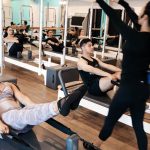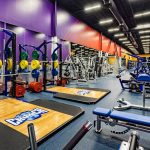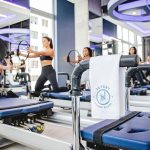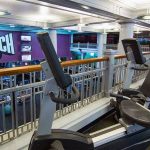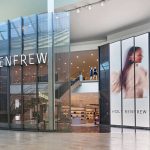Nike surpassed many milestones in their fiscal 2003 fourth quarter and year ended May 31, 2003, but Wall Street was looking ahead as the company reviewed their successes over the last year. On a highlight basis, Nike:
- Broke the $10 billion revenue mark for the first time, aided by a weaker dollar against the Euro;
Moved Gross Margin to a historically high 41.0% for the year; - Delivered diluted EPS of 92 cents for Q4, the largest quarterly earnings ever reported by the company;
Reported more non-U.S. revenue than U.S. revenue for the first time. - Saw fiscal year EPS of $2.77, excluding accounting changes, the companys most profitable in its history.
But is there trouble in River City?
The street seemed to think so after the company also reported that U.S. futures were down 10% for the period through November, due to the reductions in the Foot Locker business. In a conference call with analysts Thursday evening, the company did say they saw nothing changing with Foot Locker, but did admit that the business had declined more than expected.
Shares of NKE were off 6% overnight on Thursday and closed down 5.2% for the week to $53.08 on Friday.
Excluding the Foot Locker business, U.S. backlog was actually up 3 to 4%, said Nike co-President Charlie Denson. The futures business, which is about 75% of Nike total sales, was better for the Back-to-School period than it was for Holiday. Product that is being built for the three new basketball athletes is not in the numbers, but the company sees little effect until Spring 04.
Footwear and Apparel futures were affected equally, which came as a surprise after the company reported a 16% increase in Q4 apparel sales versus a 3% decline in footwear sales. Total year footwear sales were off 4% – up 2% on a unit basis – on top of a 1% decline last year.
U.S. Apparel sales for the year rose 8%. Margins for both apparel and footwear improved by 140 basis points for the year.
The business outside the U.S. continues to grow, with the Europe/Middle East/Africa region finishing with an exchange-rate-bolstered best-ever year at $3.2 billion. Sales in the EMEA region were up 20% for the year, but rose just 5% when adjusting for the exchange rate benefit.
Germany remains tough as Nike goes head-to-head with hometown favorites adidas and Puma. Denson said they are not losing share, but not growing at a rate they want either. He sees it as a battleground as the Olympics approach. The business in the U.K. and Italy appear to be stabilizing and showing some improvement, but the U.K. market — where Nike feels they are maintaining or gaining share-is still impacted by consolidation and inventory clean up with key retailers like JD Sports and JJB Sports. NKE sees a “very strong” trend in Italy.
The gross margins improvement in EMEA accounted for 60 basis points of the companys consolidated margin improvement. Better in-line pricing margins and lower levels of closeouts and cleaner inventories, drove about two-thirds of the improvement, while currency changes accounted for the balance.
In the Asia Pacific region, Korea drafted off of last years World Cup to post a 44% increase in sales for the year. China grew 39% and exceeded the $100 million milestone for the first time. The Japan business, aided significantly by a new footwear fit system that reportedly improves fit for Asian athletes, grew by 17%. Japan is also jumping on Jordan Retro product.
Revenues in A/P increased 19% for the year, or 14% on a currency-neutral basis. The 220 basis points gain in gross margin here accounted for 30 basis points of the GM improvement for NKE. The margin increase was a result of higher in-line margins and cost leverage in the Japanese and Korean distribution facilities, more than offsetting weaker hedge rates across the region.
The Americas declined 7% for the year due to weaker currencies in the market, and would have been up 8% on a currency-neutral basis in 2003. The 300 basis point GM improvement, sparked by higher in-line margins and lower levels of closeout sales, gave a 10 bps assist to the NKE margin gain.

In the U.S., the team pointed to the “highest pre-tax profits ever” for the region as one of the few bright spots. NKE has clearly tightened things up here as the business softens and was quite adamant about delivering the profit contribution going forward.
On the analyst call, the company shrugged off suggestions of a trend shift back to brown shoes, calling it “overstated”, but did indicate that they saw a real move into active lifestyle looks that they expect to capitalize on moving forward.
The company did indicate that they saw weakness in the value (mid-market) channel, where they “anticipated stronger futures orders” for Holiday. They see the issue due to stagnant inventory from other vendors, both athletic and non-athletic, and that the Nike inventory position appeared to be “okay”.
In addressing the apparel issues, Nike said it was primarily an internal issue, and that they felt they have addressed the delivery issues that have plagued them. Nike co-President Mark Parker said the Black Label performance product has grown to 36% of apparel sales.
Nike Retail was also seen as a positive in the U.S., reporting a 12% same-store sales increase in May and a 10% gain for the whole quarter.
The subsidiary business gained 12% on the year, with revenue growth at Nike Golf and Cole Haan, coupled with a full year of revenue from Hurley, offsetting declines at Bauer Nike Hockey. The company did say that they were a “little too aggressive” in the golf division in a “down trending market”, hinting at poor operating results in the unit.
Wholesale inventories were also an issue, growing more than 10% year-on-year. The company said they brought fall goods in early to “better serve their customers” for the B-T-S period.
Regarding the price deflation issue seen in the overall market, Nike said they saw average unit prices stabilize in Fall bookings and actually increase going into Holiday. Parker said the company has also been able to reduce product costs on key Active Life products by as much as $1.00 a pair, which has protected margins.
The recent signings of key basketball endorsers Kobe Bryant, Carmelo Anthony and LeBron James is not expected to impact the companys overall sports marketing spend, with demand creation still seen in the 11% range for fiscal 2004. There were no new pay-outs made in the fiscal 2003 from the new deals. (Page 5)
NKE sees fiscal 2004 first half revenues up in the “mid-singles” and sees total year sales in the “high single digits”, while expanding gross margins and EPS growth in the “mid-teens”. The growth is expected to be concentrated in Spring 04 the back half of the year, as NKE sees “challenging comparisons in the first half” of the fiscal year.
>>> The pain associated with the Foot Locker spat looks like it may hurt more than expected going forward. Even Nike cant re-create that much revenue this fast…
>>> The growth in the International business to offset the Foot Locker issue cannot rely on the benefits of exchange rate changes forever…
>>> We will not be surprised when we see early Kobe and LBJ product when the NBA season kicks off. Sounds like holiday will need the boost…











